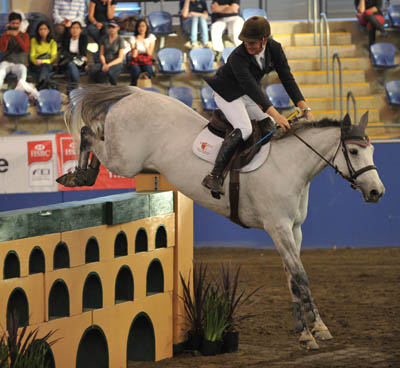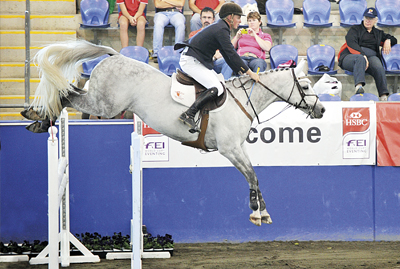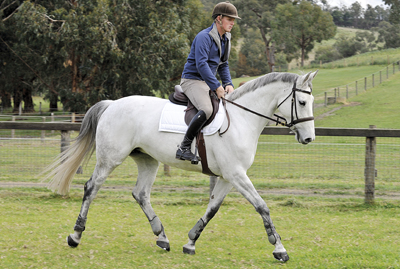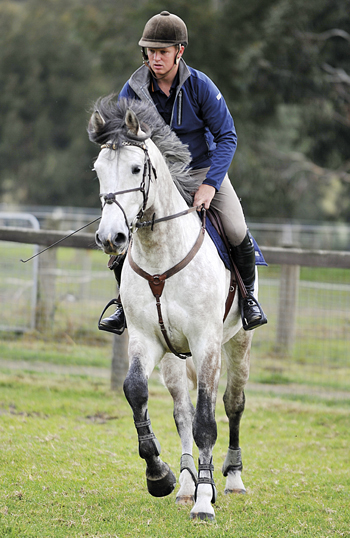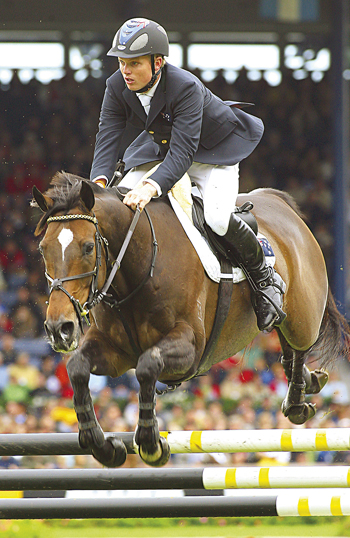Jamie Kermond rocketed into the frame with a wonderful little Thoroughbred, Stylish King, and made the team to the WEG at Aachen in 2006. After the sale of Stylish King, Jamie had to re-group, and find himself some new front-liners. It’s four years since Aachen, but Jamie Kermond looks well and truly on his way, with two lovely World Cup horses, the stallion, Valhalla, and the mare, Colthaga, who started the season in grand style winning the World Cup Qualifier at SIEC on the Weekend of World Cups in early May.
Colthaga wins the big World Cupper at SIEC
We visited beautiful Gippsland to watch Jamie working with both Valhalla and Colthaga, and then ‘play around’ with an exciting four year old stallion, Caracas by Cassal out of Colthaga.
It was a real change over for Jamie, from the off the track model to the imported jumpers. I wanted to know how big a change it had been?
“It has been a big change of my riding style. Stylish King was a Thoroughbred but he was a quiet one. When I started riding him he didn’t really want to go. But I did ride a lot of Thoroughbreds off the track. The change over to the Warmbloods has been a huge change for me, I’ve had to really learn to use my leg – and I’ve still got a lot of improvement to do in terms of riding the Warmbloods. They are the right horses to be riding these days, but I do miss the little hot Thoroughbreds…”
Jamie and the imported stallion, Valhalla
How long have you been riding Valhalla?
“Just on four years now, when we got him, he’d done one season of metre courses and he was really, really green. Des Russell imported him as a three year old and broke him in. Hayden Kneebone rode him for a season, and just got him out to some shows. When I got him, he was ready to start pushing on. It was time to start turning him into a jumper.”
Did he always feel special?
“He doesn’t feel that spectacular over small fences. When you jump him over fences, a metre, to even a metre fifteen, he sort of looks down at them all the time and he doesn’t give you a great feel – but as soon as you put a big fence up in front of him, he always gives a great feel.”
What does his training program look like?
“He has got a really good canter but it is all front end. We’ve got to really work on getting his back end more underneath him and getting more power in his canter. His jump is always pretty safe, he has a good technique. We do a little bit of jumping. We try very hard to get him straight. He gets a little bit lazy when you make him work, he’ll get his body all crooked to make it easy for himself. His main thing is his canter, and there is still a lot of improvement in there.”
“I work a lot on collection, shortening and lengthening the stride, even using a dressage whip and giving him a tap occasionally so he is thinking about his back end.”
Have you found you have to improve your dressage technique to ride these Warmblood horses?
“I do have to improve my dressage. At the moment, I am a full-time farrier so I don’t get as much time as I would like to ride. Now with these two horses looking like they are ready to take the next step, it’s time for me to get some proper dressage lessons. I know that is my next big thing. I know how to jump a horse, I can see a good distance, I’m pretty confident how I ride in the ring – it’s just the dressage training that is the next thing to improve.”
Working at home with Colthaga…
How long have you been working with the mare, Colthaga?
“We’ve had her for eight months. I was lucky enough that the Cox Family bought her for me from Chris Chugg. I went up there to ride the young stallion, Caracas, and he showed me her in the paddock and told me she would suit me. She is quite an interesting horse. She gives you a great feel, a great jump, pretty natural canter, she is another you just have to work on the basics…”
What had she done when you took her over?
“Amanda Madigan rode her. She was a D Grader. Amanda started her in a Futurity at Wodonga. I think it got to one fifty, one fifty five – she was third in that, jumped amazing but it frightened her a little bit. Then she went backwards for a little while. Chris Chugg started riding her, took her to Sydney Royal and ended up getting a third in a Part Three class. He started her in the Mini-Prix at Copabella. So she had done enough but was still quite green. When they imported her, she had a foal, then we had EI, so she is a nine year old but she rides more like a seven year old.”
That was her first World Cup start at Sydney?
“It was.”
Did you go in thinking you would win?
“No I didn’t. These big Warmbloods, it doesn’t matter what height the fences are, they go in and just jump whatever it is. With her, when I walked the course, I thought there was one big fence – the one with the water – that was a big vertical, and everything else looked alright. The treble was a bit tricky, off the corner… at a normal show, it would have just looked like a Grand Prix class. I didn’t go in thinking she would win, I was just hoping to get around and look nice, and do some nice jumps, but I also knew she was capable of jumping a clean round.”
The young stallion, Caracas, how long have you been working with him?
“We’ve had him about 12 months now but because I have been going away a bit with the other horses, he has missed out on a lot of work. He’s still really green, he rides like a real baby. He’s a five year old but I think he will be seven before he starts to look like a really impressive horse. He’s got a lot of potential and ability there but it is just going to be a time thing for him. At the moment, I am taking it really quiet. I just want to get him out and show him around, show him different courses and different fences, and get him confident over the next 12 months, then we will get a little more serious with him.”
Caracas – just playing…
The Warmbloods don’t have the fitness base that the ones off the racetrack have…
“That’s a big difference that I have noticed. The ones you get off the track, they have already galloped, they have done a lot of stuff, so they have a fitness base – but these Warmblood, you get them, and you canter them for five, ten minutes, and they feel absolutely knackered. I was galloping him around for 10, 15 minutes the other day, trying to get him to do a bit of work, and he knocked up pretty quick.”
Where did you catch the showjumping bug?
“I’m from Warrnambool, my family was all racehorses. My Dad was a jockey, my Mum trained horses. My step-Dad was a trainer. My brother met Nick Mackay who used to do a bit of jumping around the local shows, and Gary got involved with him. I started tagging along… then Gary stopped riding Red Shiloh, an Anglo Arab, and I got him. He wasn’t that special a jumper but when I got him, something clicked, and he started winning lots. He won the young horse class at Melbourne Royal, he was really good for me. I jumped him in the Mini-Prix at Shepparton one year, and Ronnie Easey is going, ‘what’s that horse?’ I remember jumping down the last line and I lost both my stirrups and he kept jumping through it for me.”
“I jumped him in A and B grades around the local shows, one thirty classes. He was only about 15 hands.”
The next good one?
“When I was riding him, Stylish King came along. My Mum found him while I had Red Shiloh at Adelaide, that was my first Royal and I was doing no good at all. I hadn’t got around a course the whole show. Mum rang me and said, ‘I’ve got your next good horse’ – yeah, whatever. I got home to ride him and I couldn’t even get him to canter, I couldn’t do anything with him. I almost gave up after the first day, but then I put him over a cross rail and he almost jumped the wings.”
All the way to Aachen with Stylish King
You never dreamed he would take you to a World Championship at Aachen?
“No, when we got him, he was a hurdler, and he had bowed his tendon twice in one leg, and bowed a tendon in another leg, once – he didn’t have the best legs to start with. He was about 16.1 but he was an absolute freak. The size of his heart was freakish, what he could do.”
Did that give you the taste for it, going to the WEG in 2006?
“It opened my eyes. It’s one of those things that when it’s finished, you wish you could have your time again. I got home and I was pretty much depressed for six months…”
But you went well…
“No. You go over there and everyone expects you to go no good because you haven’t been over there before. But I wouldn’t have gone if I didn’t think I was going to go as well as I would have liked. Then when you don’t go as well, everyone else thinks, oh that’s alright, but it wasn’t for me. After that six months, I started riding some good horses again, and I want to get back to it. I want to go to an Olympics or another WEG, that is my goal now.”
You ride with the stirrup on your toes – why?
“There was Albert Voorn riding Lando at the Sydney Games, and I watched him. He rode with his toes, and I really liked his style. His leg never moved. I rode a lot of trackwork and all the jockeys ride on their toes. So it was just a balancing thing for me. I like full control in the stirrup all the time. When I was younger and going through the grades, I always used to lose stirrups. I don’t like it, so I practiced riding on my toes so I can keep a feel of my stirrup. In the ring I ride with a bit more foot in the stirrup so I don’t have to concentrate on it so much.”
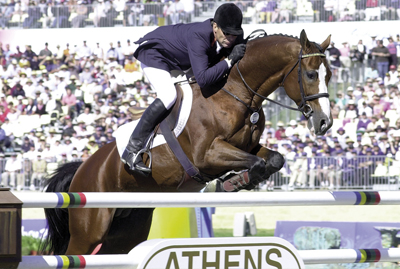
Albert Voorn on his tippy toes…
Who have been the influences on your style?
“All the good riders in Australia, Jamie Comans, George Sanna, Rod Brown, all those guys, but the main thing I remember learning, I went over on a young rider trip with the Victorian team to England, and after that I was lucky enough to be able to stay at John Whitaker’s for a few weeks, and went to shows with him. Watching him ride at home, and at shows, he’s just amazing. It looked like he did nothing all the time, just the horses would jump for him.”
“I remember getting back and going straight to a show, and I tried to ride like him and just do nothing, and it sort of worked for me. That was the main thing I learnt…”
That’s what George Morris says, the great riders are the very cool riders like Whitaker, who don’t seem to be doing anything…
“That’s right. When you are jumping a horse around a show jumping course, I like the horse to be concentrating on me 30 maybe 40% but the other 60% you want him concentrating on the fences. If you get your horse right before you go out, get a good canter and ride to a nice spot every time, them you just leave them alone and let them do what they are bred to do.”

Story by Chris Hector & Photos by Roz Neave





